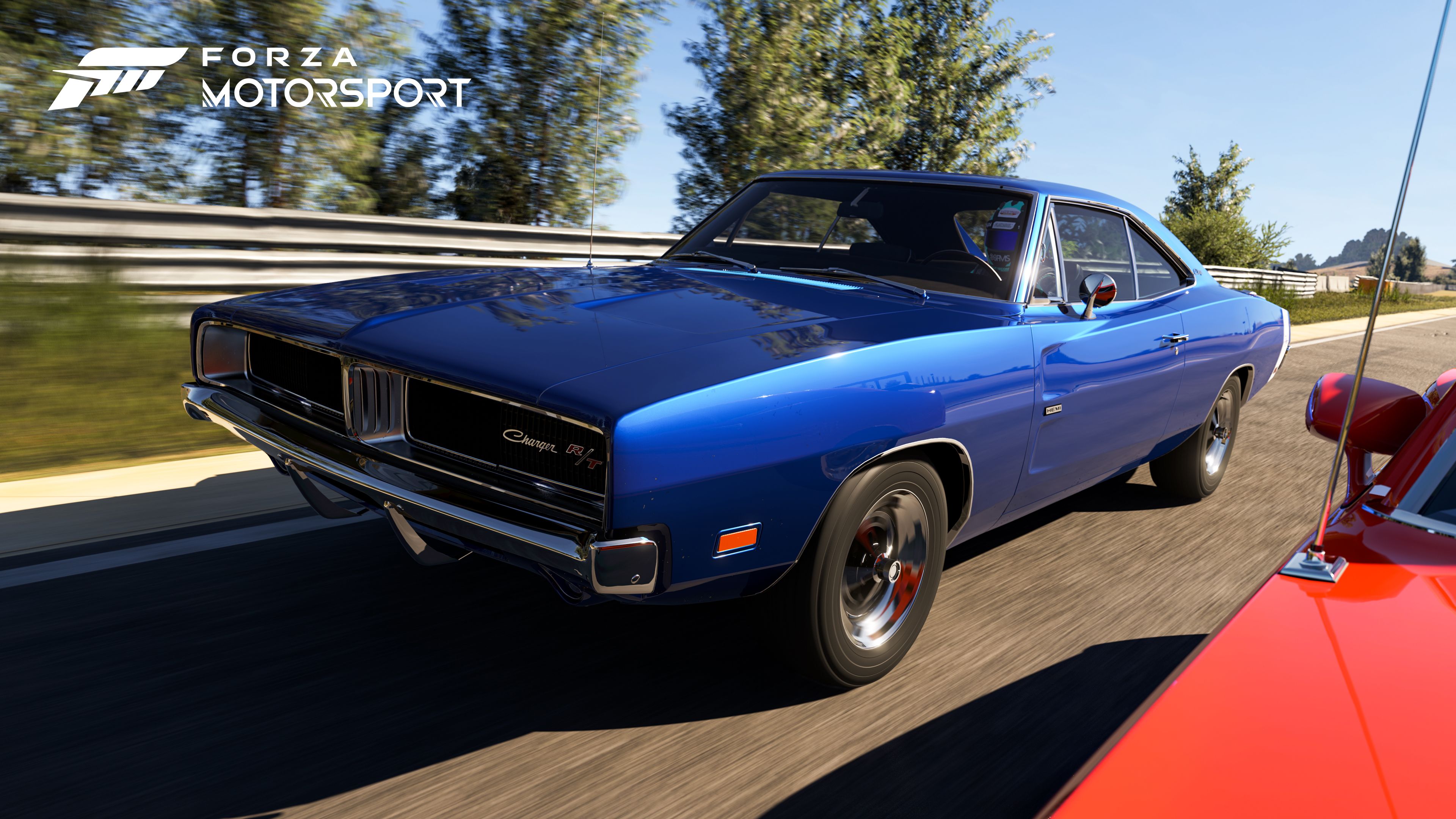Brandon Cole picks up a controller, sits down and hops into the new Forza Motorsport game, which is coming to Xbox and Windows later this year. He’s making tight turns, drifting through tricky patches of sand and speeding to the finish line. None of this would be remarkable, save for the fact that Cole is completely blind.
Cole, who consults on many top titles, has been working with Turn 10 Studios and Xbox to make what Microsoft is calling the most accessible Forza Motorsport ever. It’s packed with features to let folks with limited eyesight, hearing and mobility still enjoy the game’s ultra-realistic racing action, including a breakthrough Blind Driving Assist mode that could seriously level the playing field for low-vision gamers. To get a deeper dive, I spoke to Cole as well as Turn 10 Studios’ gameplay and accessibility producer Neha Chintala and head of Xbox Phil Spencer about bringing these features to life, and why an accessible game is a better game, no matter what kind of player you are.
Built from the ground up for the new Xbox Series X and S consoles, the latest Forza Motorsport game promises ultra-immersive simulation racing and the series' most robust accessibility features yet.
Making the most accessible Forza Motorsport yet
The Forza series (which consists of the arcade-y, open-world driving of Forza Horizon and the hardcore racing simulation of Forza Motorsport) has long offered basic accessibility features, from menu narration for the visually impaired to various assists that help keep less-dexterous drivers on track. But according to Cole, who worked on the award-winning accessibility features in Sony’s mega-popular The Last of Us 2, the franchise was simply not meeting the needs of the blind.
“From my perspective, Forza was not a blind-accessible game,” says Cole. “There are those who would disagree with me on that. I know blind people that play Forza Motorsport 7 using the tremendous amount of steering assist, which Forza 7 does have, and that’s great. But the way that I envision things when I’m doing this work is I want to offer players more. I want to offer them as close to the equivalent of a sighted experience as I can.”
That desire to offer blind gamers an authentic Forza experience is what led to the creation of Blind Driving Assists, a suite of features that use a range of detailed audio cues to help low- or no-vision players drive around the game’s true-to-life racetracks. This includes audio descriptions about your car’s position, detailed sounds that guide you through turns and even a heads-up once it’s time to shift gears if you’re driving manual. And as with all of Forza’s accessibility options, players can toggle specific assists to best suit their needs.
“One of the first things I did was listen to a video of the current prototype in action and tell them how wrong they were about it all,” jokes Cole. “No, they weren’t completely wrong, but basically a lot of things were essentially just very similar audio cues. And so we worked really hard on separating those things, figuring out the different sounds that we could use for each different audio cue and how those would work together. It’s not just one feature, it’s a suite of features working together to make this game blind-accessible, and any one of them you could turn off entirely if you don’t feel like you need it.”
Forza Motorsport’s Blind Driving Assists are just part of a long list of features designed to make sure as many people as possible have the opportunity to hop behind the wheel of the game’s massive lineup of authentic sports cars. This includes one-touch driving that allows players to cruise around with minimal button presses, customizable screen narration for low-vision players, fully remappable controls and text-to-speech/speech-to-text features that allow more folks to engage in in-game chat with other drivers online.
And, of course, Forza Motorsport supports the $100 Xbox Adaptive Controller, Microsoft’s specialized controller meant to assist gamers with limited mobility with its large inputs and support for a wealth of external accessories.
Related: Here’s how blind gamer Steve Saylor creates awesome accessibility content
How accessibility is a win for everyone
As I spoke with Cole and members of the Xbox team, a common theme popped up: You can never quite predict how players are going to use your features.
“One of the things that has inspired me in terms of my background with game development is those unanticipated uses of things that you build in games,” says Spencer, who’s been at Microsoft for decades and has lead the Xbox brand since 2014.

“I remember early on in Kinect days, and I know there’s kind of a lot of [criticism] around Kinect [Microsoft’s ill-fated motion control accessory], but I would get notes from parents with kids, whether autistic kids or kids where controllers were a barrier to their ability to play. You’d get these videos of these parents sometimes in tears of happiness or just [saying], ‘this is the first time I’ve been able to play as a family.’”
Those anecdotes helped motivate Xbox to make more deliberate accessibility decisions, such as adding accessibility tags to the Xbox store so that players can find games that suit their needs, or releasing the aforementioned Adaptive Controller. The latter device has been met with largely rave reviews since it first released in 2018, and more crucially, is designed to work even on non-Xbox platforms.
“We never wanted to make Adaptive Controller an accessory to one hardware platform,” says Spencer “There were kind of a few unlocks. One of them was price point … we wanted to make sure it was accessible to a lot of people at the price, given some of the custom solutions that are out there that can be pretty expensive. And then we wanted to open up the accessory side of it because we knew that when you’re working on making games accessible to people with disabilities, you kind of have to start with the one instance of what works for an individual and then try to make it more accessible to more people.”
When asked about what to expect from future Xbox accessibility products, Spencer says, “It will be a combination of software and hardware, and this is definitely something that has its own momentum inside of the industry right now and we’re?glad to be a part of it.”
Just as an oft-forgotten accessory like Kinect can find a home with the accessibility community, many accessibility features have ended up being a hit with the larger gaming fanbase. After all, how many of us use subtitles in Netflix or have Siri read aloud texts for the sheer convenience?
“Imagine that you are someone who is at home and needs to run to use their restroom, or you have something that you’re cooking in the kitchen or you have a child that needs your attention,” says Chintala. “We have our audio descriptions turned on. And so if you’re not there watching the scene itself, or reading the subtitles, the audio descriptions can also give you that same information without you needing to be present in the room.”
Cole shared an especially memorable anecdote that drove home just how useful these extra tools can be — even in ways the developers may not have intended.
“Shortly after the release of The Last of Us 2, I was given a story about someone who was using a feature that I helped design in that game, which was navigational assist, and I designed that feature for the blind, of course, to help them navigate through the 3D world. But this person was sighted,” said Cole.
“Reading on, I found out that the reason they did it is because they were stressed out by the game’s running sequences and didn’t want to have to worry about where they needed to go. They just wanted to get there. So the point I’m making is you just never know. Accessibility is always the right answer and always a win.”
Bottom line

When Forza Motorsport (which is actually the eighth game in the series despite its rebooted title) arrives on Xbox Series X, Series S and gaming PCs later this year, it has the potential to be played by more gamers than ever thanks to its ultra-accessible design. That includes blind players who may have never had the opportunity to drive a car in real life.
“The level of control we’re providing is now going to require [blind gamers] to learn things about cars they may not have needed to learn before if they want to take full control of the vehicle,” says Cole.” You know there is a learning curve, there’s a lot to learn, but a lot of it is because they’ve never driven and that’s the approach we have to take in designing these features.”
Cole was quick to stress that learning Forza Motorsport — which is already a complex driving sim — won’t be easy for the blind community. But these features are shaping up to level the playing field (or racetrack) in a way that’s never been done before, providing a space where racing enthusiasts of all kinds can speed around regardless of their vision level.
“We’re going to be allowing folks to do things that they’ve never been able to do before,” says Chintala. “And that is just exciting.”






















